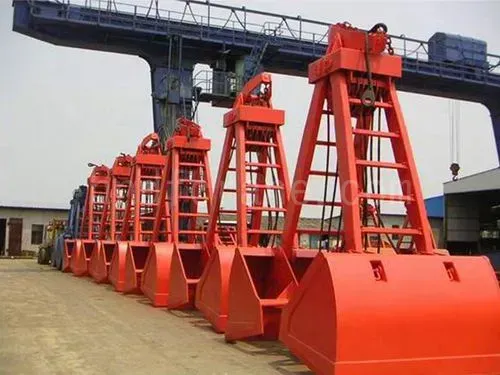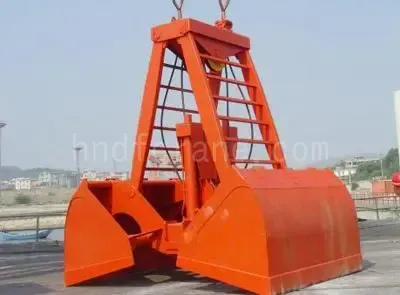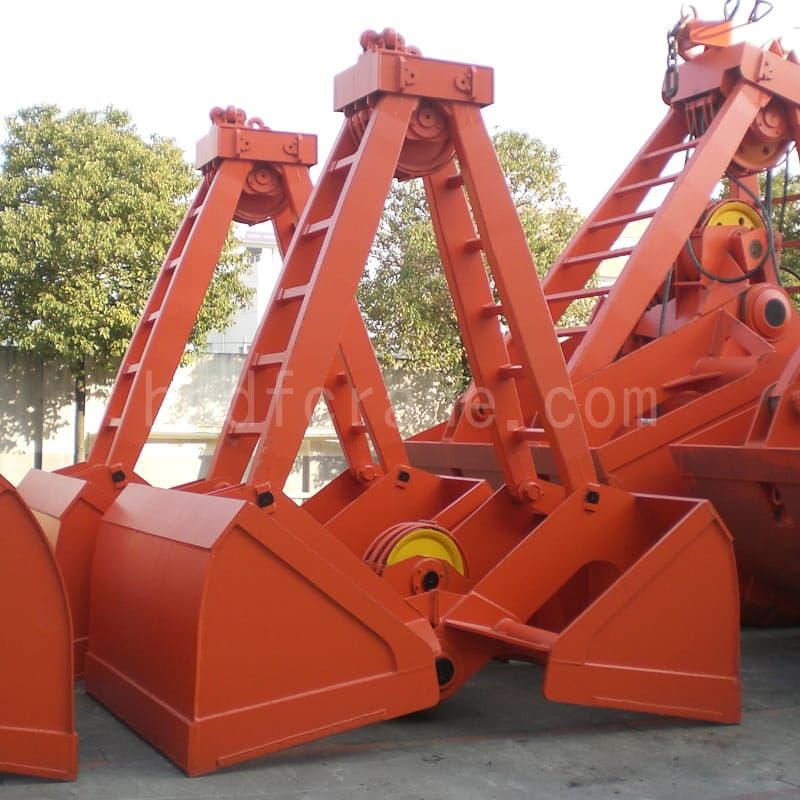Pengenalan Produk dari pegangan kerang tali mekanis dua
Genggaman kerang tali ganda mekanis ini cocok untuk semua jenis derek dengan struktur perangkat pengangkat ganda, dan sebagian besar digunakan di pelabuhan, dermaga, jalan dan jembatan konstruksi, dan industri lainnya.
Berdasarkan karakteristik materialnya, dapat dilengkapi dengan beban ringan, sedang, berat, dan sangat berat. Cocok untuk mencengkeram semua jenis timbunan lepas.
Kemudian berbagai macam derek. Dilengkapi dengan dua set motor rol (yaitu kerekan listrik), setiap set rol mengarah ke tali kawat, yang satu berfungsi sebagai tumpuan pada rangka keseimbangan grab, dan tali kawat lainnya melewati katrol balok atas dan bawah untuk membentuk blok katrol, yang berperan dalam pembukaan.
Genggaman kerang mekanis dengan dua tali merupakan alat efektif untuk memuat dan menurunkan muatan curah seperti pasir kuning, batu bara, bubuk bijih, dan pupuk curah di berbagai lingkungan yang keras.
Genggaman kerang tali dua mekanis mempunyai struktur sederhana, mekanisme pembukaan dan penutupan baru, mudah dioperasikan, dan dapat secara akurat menyelesaikan tindakan pembukaan dan penutupan dalam berbagai keadaan.
Pegangan mekanis dua tali mengadopsi desain virtual tiga dimensi, dan perangkat lunak ANSYS digunakan untuk analisis dan verifikasi kekuatan. Distribusi berat lebih masuk akal dan masa pakai lebih lama.
Balok bantalan atas dari pegangan kerang tali mekanis dua dilengkapi dengan lug, yang dapat dihubungkan langsung ke belenggu tali pengangkat derek.
Parameter teknis dari dua pegangan kerang tali mekanis

| Tipe dan Ukuran | Volume(M3) | Berat Mati (t) | Dimensi (mm) | Sheave Dia.(satuan ukuran) | Gunakan Tinggi(M) | Tali Baja Dia.(satuan ukuran) | Bahasa Inggris Raya(T) | ||||
| A | B | C | D | Bahasa Inggris | |||||||
| BS3[1.2]1.3A | 1.2(300) | 1.4(4) | 1900 | 2537 | 2488 | 2841 | 1200 | tahun ø400 | 9 | ø17,5 tahun | 3 |
| BS3[1.6]1.4A | 1.6(300) | 1.4(4) | 2100 | 2631 | 2559 | 3040 | 1300 | tahun ø400 | 9.5 | ø17,5 tahun | 3 |
| BS5[1.5]2A | 1.5(350) | 2(3) | 2000 | 2659 | 2667 | 3075 | 1260 | tahun ø445 | 8.5 | ø19,5 | 5 |
| 2(4) | 9.8 | ||||||||||
| BS5[2]2A | 2(350) | 2(4) | 2100 | 2778 | 2818 | 3248 | 1400 | tahun ø445 | 10 | ø19,5 | 5 |
| BS5[2.5]2A | 2.5(350) | 2(3) | 2100 | 2787 | 2715 | 3091 | 1600 | tahun ø445 | 8.5 | ø19,5 | 5 |
| BS5[3]2A | 3(400) | 2(3) | 2300 | 3130 | 2938 | 3362 | 1650 | tahun ø445 | 9 | ø19,5 | 5 |
| BS8[2.6]3.2A | 2.6(300) | 2.6(4) | 2300 | 3038 | 3257 | 3736 | 1800 | tahun ø560 | 11 | ukuran ø26 | 8 |
| BS8[3]3.3A | 3(300) | 3.3(4) | 2380 | 3118 | 3287 | 3786 | 1900 | tahun ø560 | 11.5 | ukuran ø26 | 8 |
| BS8[3.8]3.5A | 3.8(300) | 3.5(4) | 2550 | 3536 | 3286 | 3733 | 2000 | tahun ø560 | 12 | ukuran ø26 | 8 |
| BS8[4.5]3.8A | 4.5(300) | 3.8(3) | 2500 | 3505 | 3503 | 3975 | 2300 | tahun ø560 | 12 | ukuran ø26 | 8 |
| BS10[3]4A | 3(300) | 4(4) | 2380 | 3118 | 3287 | 3786 | 1900 | tahun ø560 | 11.5 | tahun 28 | 10 |
| BS10[5]4A | 5(350) | 4(4) | 2615 | 3605 | 3503 | 3975 | 2400 | tahun ø560 | 12 | tahun 28 | 10 |
| BS10[6]4A | 6(400) | 4(4) | 2800 | 3814 | 3758 | 4290 | 2150 | tahun ø560 | 12.5 | tahun 28 | 10 |
| BS16[3.6]6A | 3.6(300) | 6(5) | 2500 | 3313 | 3810 | 4206 | 2100 | tahun 720 | 13.5 | ø32 | 16 |
| BS16[4]6A | 4(350) | 6(5) | 2500 | 3313 | 3810 | 4206 | 2200 | tahun 720 | 13.5 | ø32 | 16 |
| BS16[6]6A | 6(350) | 6(4) | 2900 | 3800 | 4249 | 4612 | 2400 | tahun 720 | 13.5 | ø32 | 16 |
| BS16[10]6A | 10(400) | 6 (3) | 3200 | 4000 | 3938 | 4673 | 2500 | tahun ø650 | 12 | tahun 28 | 16 |
Cara memilih grab yang tepat
- Jelaskan tujuan Anda:
Sebelum menyelami pilihan-pilihan yang ada, mohon jelaskan persyaratan spesifik Anda. Tanyakan pada diri Anda sendiri:
- Material apa yang ingin Anda tangani?(Kayu gelondongan, besi tua, batu, dll.)
- Tugas apa yang akan dilakukan oleh grab? (Memuat, menyortir, membongkar, dan lain-lain)
- Jenis perangkat apa yang akan dihubungkan dengannya? (Gantry crane, overhead crane)
- Berapa berat jenis material yang Anda ambil? Berapa jumlah kubus yang Anda ambil?
Berapa tonase crane Anda yang dilengkapi grab?
Menurut karakteristik material yang dicengkeram, cengkeraman biasanya dibagi menjadi empat jenis dasar: ringan, sedang, berat, dan super berat.
| Jenis material yang akan diambil | Ambil bahannya | Berat kapasitas (t/m³) |
| Lampu | Kokas, terak, biji-bijian, kentang, kapur antrasit kualitas sedang, semen, tanah, kerikil, tanah liat, pecahan batu bata, dll. | 0.5~1.2 |
| Sedang | Gambut, potongan besar batu bara antrasit, batu bara padat, tanah liat, batu kapur, kerikil, garam, kerikil, batu bata, bauksit, serpihan oksida besi, semen, pasir dan batu bata dalam air, dll. | 1.2~2.0 |
| Berat | Batu kapur, tanah liat berat, bijih-bijih berukuran kecil dan sedang, batuan keras, oksida besi berbentuk batang, bijih besi, bubuk konsentrat timbal, dll. | 2.0~2.6 |
| Kegemukan | Bijih besar, bijih mangan besar, bubuk bijih timbal yang diaglomerasi secara sedimen, dll. | 2.6~3.3 |
- Kompatibilitas aksesori: Pastikan pegangan tersebut kompatibel dengan perlengkapan yang ada.
- Pertimbangan anggaran: Kisaran harga grab berbeda-beda. Seimbangkan anggaran Anda berdasarkan fungsi dan daya tahan grab.
- Komentar dan saran: Lakukan riset daring, baca ulasan pengguna, dan minta saran dari rekan industri.
- Kunjungi produsen derek untuk pemeriksaan dan pengujian di tempat sebelum membeli: uji grab dalam kondisi nyata sebanyak mungkin. Evaluasi kinerja, kemudahan penggunaan, dan fungsionalitas keseluruhannya.
Perlu diingat bahwa memilih grab yang tepat memerlukan keseimbangan antara fungsionalitas, keamanan, dan biaya. Dengan mempertimbangkan faktor-faktor ini





















































































